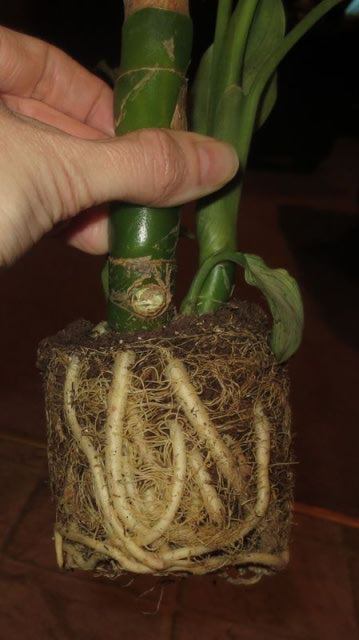Question
 Roots in 4 inch pot
Roots in 4 inch pot
As you can see from the picture the Dieffenbachia I just bought appears to be pretty badly root bound. It came in a 4 inch pot. It is winter, and I did just buy it yesterday but I'm considering bumping it up to a larger pot with new soil, it doesn't have much soil left and the plant will not stand up in that tiny pot! If you could advise me as to whether or not to pot up, by how much, and what to do with these huge roots that would be great. I don't think I'm suppose to cut those huge roots, do I just untangle them and fan them out in the new pot? I have never had much luck with plants, but I'd like to get better!
Thank you for your time
AnswerHi Megan,
Thanks for the great photo! You described your Dieffenbachia as "pretty badly root bound." I would describe it as very nicely root bound.
It is not commonly understood that plants do best when they are quite root bound. Roots do not care if they are crowded because as long as there is enough soil to keep the roots moderately moist, they will be fine. If you were willing to water your plant every couple of days, you would not need to move it into a larger pot.
However, your plant is sufficiently root bound to warrant a pot that is either 5 or 6 inches in diameter, but no larger. Make sure the new pot has drainage holes.
Your focus is on the large, fat roots, but it should be on the finer root hairs that do most of the work. Gently loosen the outer surface of the rootball so that you damage the root hairs as little as possible. There is no need to force the larger roots apart or "fan them out." The idea is to loosen the outer surface enough that the roots will easily integrate into the new potting mix that you will add.
Use a porous, peat-based soilless potting mix. Make sure it is damp before you put it in the pot. Add an inch to the bottom of the new pot or enough that the top of the root ball is about a half-inch from the top rim of the pot. Fill in the potting mix around the sides of the rootball and tamp it down so that the plant is stable in its new pot. Do NOT make the common mistake of adding soil to the top of the original rootball. When you are done, water the potting mix all around. If some of it settles below the top of the rootball, add a bit more to fill in where it has settled. Water again only when the top half-inch of potting mix feels dry.
If you use a light plastic pot and the plant is unstable even after you repot, then place the plastic pot with the plant inside of a heavier ceramic or terra cotta pot. Double-potting is usually the solution for tipping plants.
I have written articles on repotting and on Dieffenbachia care that I will email for free to you (or anyone else) who emails a request to me at
[email protected].
Please let me know if any of this is unclear or if you have any additional questions.
If this information has been helpful, please click the Rate Volunteer bar below and enter a rating and nomination for me. I am a volunteer on this site so Ratings are the only compensation I receive for answering plant questions.
Need more information? Visit my website at:
A link to HorticulturalHelp.com
or email me at
[email protected] or call me at 917-887-8601 (EST)
Regards,
Will Creed, Interior Landscaper
Horticultural Help, NYC
Visit my website at: A link to HorticulturalHelp.com






